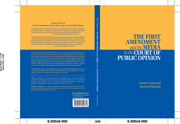Book contents
- Frontmatter
- Contents
- List of Tables and Figures
- Preface and Acknowledgments
- 1 Freedom of the Press and the Power of Public Opinion
- 2 Surveying the Public on Press Freedoms
- 3 What Americans Know About the Freedom of the Press
- 4 Public Support for the Freedom of the Press
- 5 Support for Press Freedoms Across Media: Comparing Print, Electronic, and the “New Media”
- 6 Support for Press Freedoms within a Medium: Elite, Mainstream, and Tabloid News Sources
- 7 Public Opinion, the First Amendment, and the Challenges of the Twenty-First Century
- Appendix: Annotated Questionnaires
- References
- Index
5 - Support for Press Freedoms Across Media: Comparing Print, Electronic, and the “New Media”
Published online by Cambridge University Press: 05 June 2012
- Frontmatter
- Contents
- List of Tables and Figures
- Preface and Acknowledgments
- 1 Freedom of the Press and the Power of Public Opinion
- 2 Surveying the Public on Press Freedoms
- 3 What Americans Know About the Freedom of the Press
- 4 Public Support for the Freedom of the Press
- 5 Support for Press Freedoms Across Media: Comparing Print, Electronic, and the “New Media”
- 6 Support for Press Freedoms within a Medium: Elite, Mainstream, and Tabloid News Sources
- 7 Public Opinion, the First Amendment, and the Challenges of the Twenty-First Century
- Appendix: Annotated Questionnaires
- References
- Index
Summary
When William Blackstone penned his now-classic Commentaries on the Laws of England in 1769, he spoke of the “liberty of press” as being “essential to the nature of a free state.” Among Blackstone's contemporaries, there was probably little confusion about the nature of the “press” to which he was referring. Ever since the advent of printing presses several centuries earlier, so-called “printers” had assumed their place in western Europe and elsewhere as disseminators of information. When referring to the “press,” Blackstone was speaking primarily (if not entirely) about those producers and distributors of printed materials: newspapers, pamphlets, and other written instruments that had become dominant elements of western European culture by the mid-eighteenth century. Notably, this description of the press as comprising primarily written and printed materials had not changed substantially by the time the First Amendment was ratified in 1791, as newspapers and pamphlets remained the most significant modes of mass communication in the world of the Framers (de Sola Pool, 1983:2). Nor would the character of the press change to any substantial degree during the century that followed.
It was not until the growth of radio and television as news and entertainment sources in the early and middle parts of the twentieth century that the term “press” came to encompass far more than printed materials. Radio and television reporters would soon be considered members of the press as well.
- Type
- Chapter
- Information
- Publisher: Cambridge University PressPrint publication year: 2002



